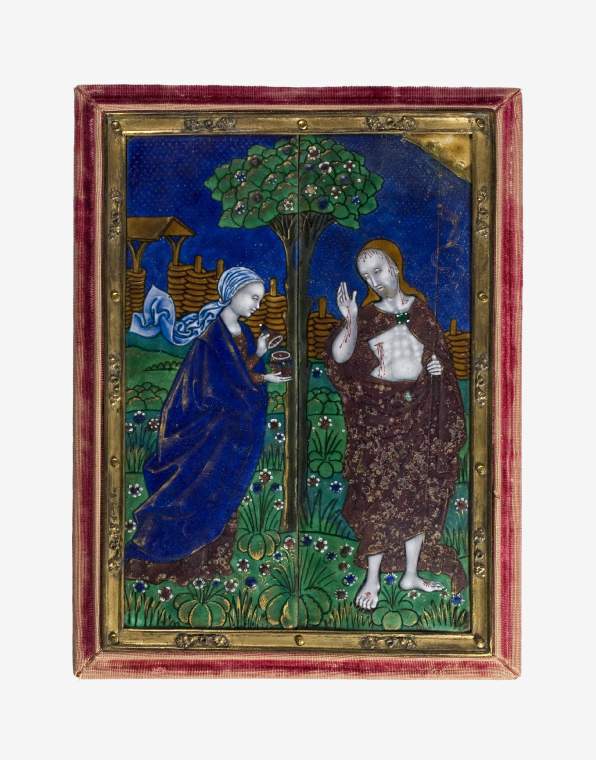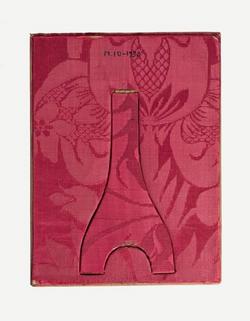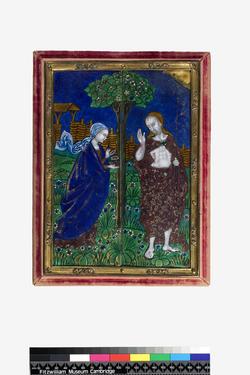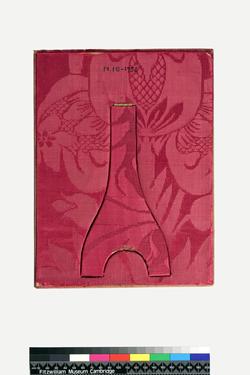Current Location: In storage
Titles
Noli me Tangere
Maker(s)
Maker:
Penicaud, Nardon
(Workshop of)
Entities
Categories
Description
Copper, enamelled in polychrome with Mary Magdalene encountering Christ after his resurrection
Two joined narrow slightly convex rectangular copper plaques enamelled over dark and white layers in translucent blue, green, red, tan, mulberry-brown, and opaque white, and gilded The flowers and jewels are backed with silver foil.
On the left plaque (A), Mary Magdalene stands in profile to right holding an ointment pot in her left hand and raising its conical lid in her right. She wears a blue and white headscarf which billows out behind her, a mulberry brown dress and a royal blue cloak. Behind her there is a tan-coloured wattle fence with a lychgate on the left. In front of her is half of a tree with a tall narrow trunk and a round top with leaves and flowers with white petals and blue or mulberry centres.
On the right panel (B), Christ stands facing three-quarters to the left, raising his right hand. to prevent the approach of Mary Magdalene, and showing the bleeding wound in his hand. Blood also trickles from his side and from the thorn wounds in his head. He has a dark brown cloak held together with a green brooch. In his left hand he holds the staff of a cross with a pennant. Behind him there is a tan wattle fence and to the left, half of a tree matching that on the other plaque.The ground of both plaques is green with numerous plants bearing daisy-like flowers with blue or red centres and white petals. The sky at the top of both panels is closely strewn with gold stars. The counter-enamel on the reverse is semi-translucent dark brown, with uneven concentrations of colour giving a mottled effect.
The rectangular gilt-metal frame has applied ornaments of a twisted stem with a leaf on each end: two on the top and bottom, and three on he sides. The outer frame is of red velvet, extremely worn on the edge. The back of the plaque is covered by a red damask-covered board with a hinged prop in the centre of more recent manufacture.
Notes
History note: Possibly George Frederick Samuel Robinson (1827-1909), London and Studley Royal, Yorkshire, 1st Marquess of Ripon and 3rd Earl de Grey (1859); certainly his son, Frederick Oliver Robinson, 2nd Marquess of Ripon, and 4th Earl de Grey, GCVO, FRS, (1852-1923), Studley Royal, Yorkshire; his cousin, Clare Vyner, Esq., Studley Royal, Yorkshire; sold Sotheby's, 19 March 1926, Catalogue of the well-known collection of old English wine glasses, etc. the property of Henry Peech Esq., . . . . A Fine large enamel, Japanese Imari ware . . . the property of Clare Vyner Esq., removed from Studley Royal. From the collection of the late Marquess of Ripon, p. 13, lot 78; sold to S.J. Phillips. 113 New Bond Street, London, W1, for £410 on behalf of Leonard D. Cunliffe (1860-1937), 109 Eaton Square, London, and Trelissick, Cornwall; bequeathed by him
Legal notes
L.D. Cunliffe Bequest, 1937
Mary Magdalene’s meeting in the garden with the risen Christ whom she at first supposes is a gardener is described in the Gospel of St John (20:14-18), and more briefly by St Mark (16:9-10).
The design may have been derived from more than one printed source. Possibly Martin Schongauer’s Christ appearing to Mary Magdalene, which has a fence and tree in the background but shows Christ with his arm outstretched and Mary Magdalene kneeling with her ointment pot beside her on the ground, and his Resurrection for the position of Christ’s raised hand. Comparable scenes with a central tree occur in manuscripts, such as a Flemish or northern French Legenda Aurea of c. 1480-1515, in the Fitzwilliam (MS 22, fol. 45 v) .The standing figure of Mary Magdalene might have been influenced by one of a series of forty-eight roundels for use by goldsmiths by Israhel van Meckenhem (1440-1503) after Master ES, which shows her standing holding her jar and wearing a turban-like cap with streamers at the back.
The plaques can be compared with three other versions of the same subject. One, likewise on two plaques, whose present location is unknown, was formerly in the collection of Prince Czartoryski, in the Château de Goluchow, Poland.This has a tree divided between the two plaques, and a Magdalene who kneels holding her ointment pot in her right hand but it is not by the same enameller. The background is reminiscent of the central panel of a triptych in the Bargello, attributed to the Monvaerni Master (Pseudo Monvaerni) by Marquet de Vasselo, but at present to an anonymous enameller, which features an analogous wattled fence with a lychgate on the left, and a tree in the centre, but different figures of Christ and the Magdalene. A smaller version of the Noli me tangere on one plaque is in the Musée des Arts Décoratifs, Paris (see Blanc, 2011).
On entering the collection the two plaques were attributed to Nardon Penicaud and there seems no reason to change that. The design of the body of Christ and the draping and fastening of his cloak are fairly close to those of the Risen Christ in the right wing of a two-stage triptych attributed to Nardon Penicaud in the Frick Collection.

 IIIF Manifest
IIIF Manifest






